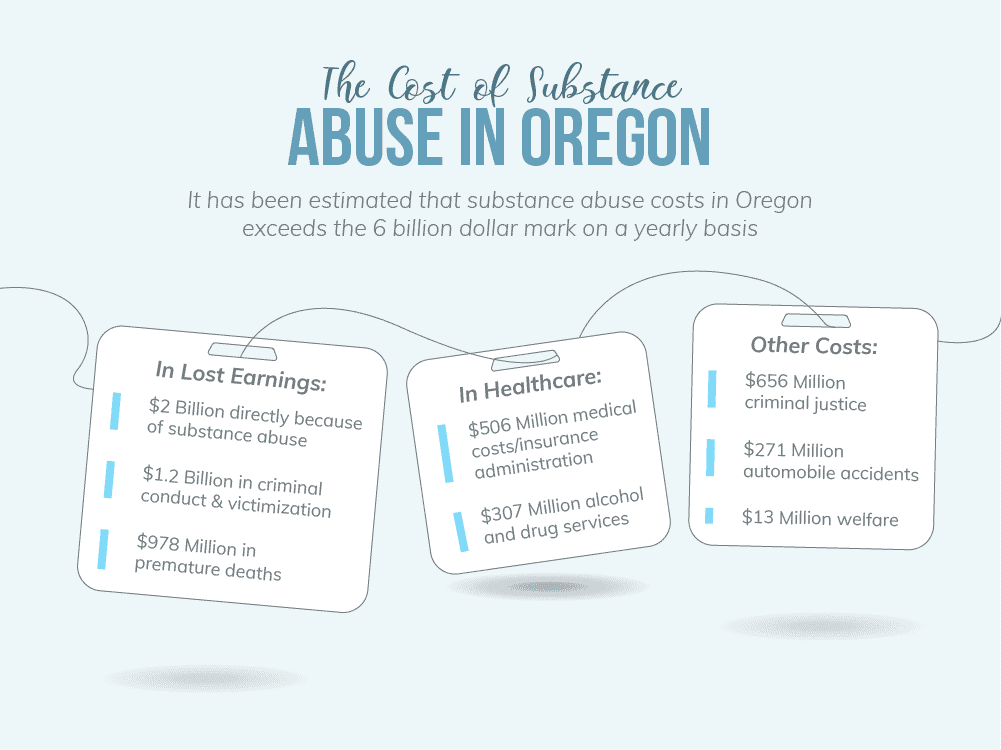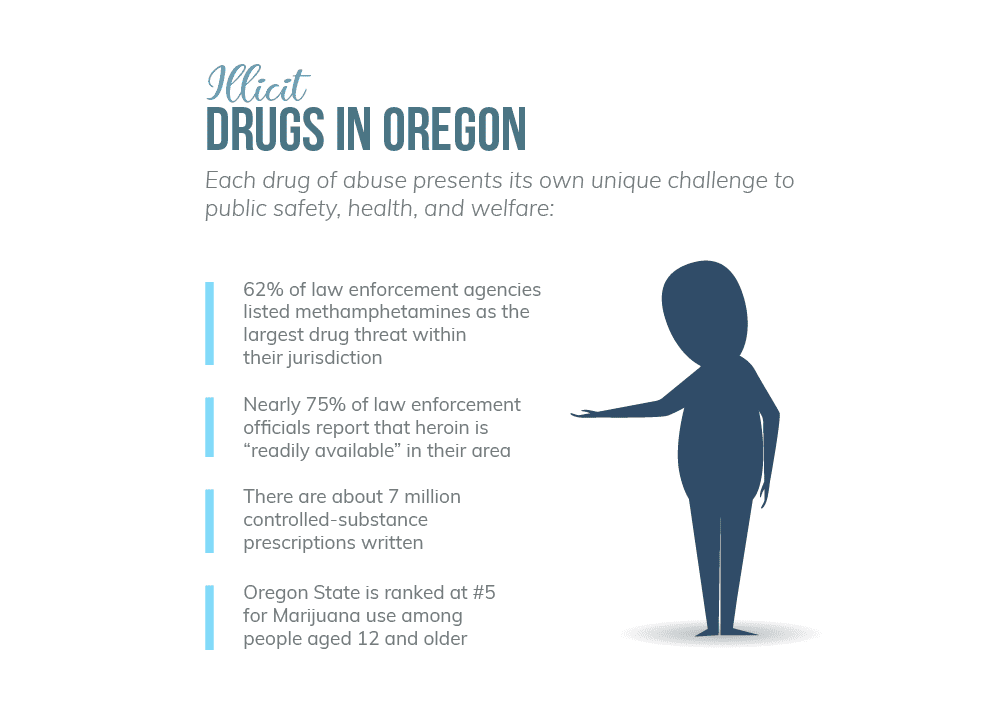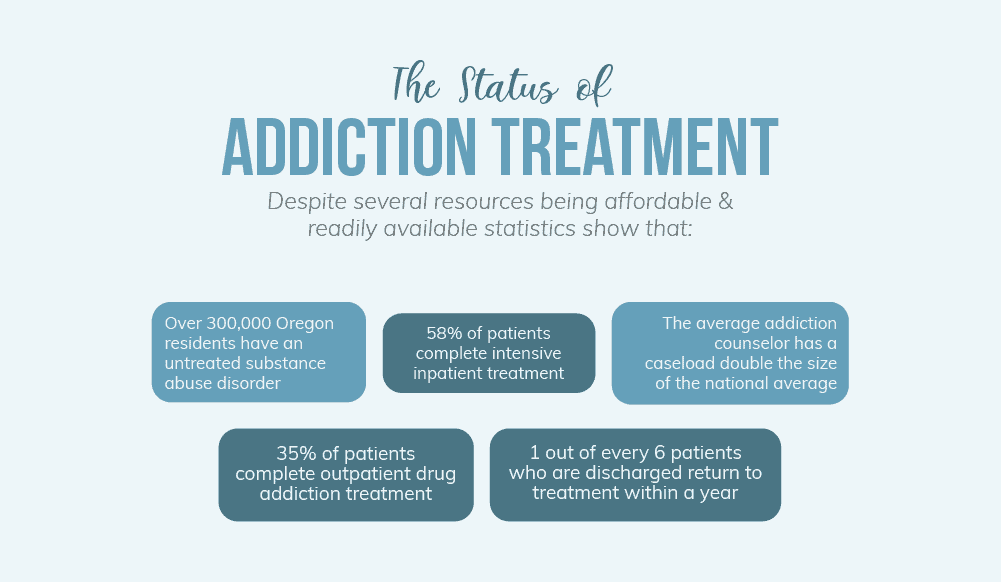The Portland Oregon drug problem is scary, and identifying the true scale of the substance abuse problem here is key if effective remedies are to be found. Here is a sobering look at addiction in Oregon. “What many don’t realize is that someone with a serious addictions disorder is going to have their body fall apart in a relatively short period. They are going to become disabled, if they don’t die first. They’re going to end up costing the taxpayer an enormous amount of money treating their serious health conditions, and then they are going to die early.” ~ Consultant Dale Jarvis, after studying Oregon’s addiction treatment system Just as it is elsewhere in the United States, substance abuse in Oregon, in the form of drug addiction and alcoholism is a major problem. In fact, an examination of available data has led some to call the issue an “undeclared emergency” in the state. 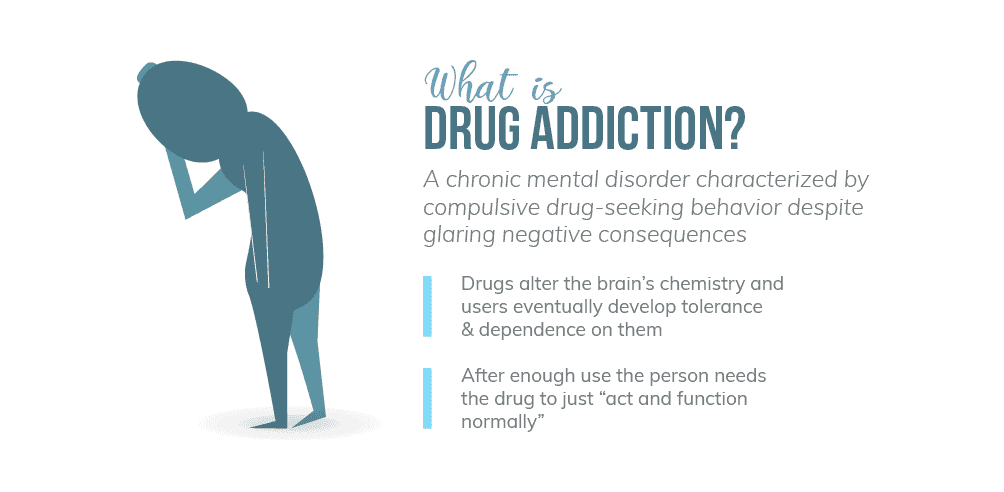
What is Drug Addiction?
A drug addiction is a relapsing, chronic disease involving drug-seeking behaviors. A drug addict acts compulsively and uncontrollably where drugs are concerned. It is also characterized by significant changes in the brain. These changes have been shown to have a direct impact on the way people act and think. Someone who suffers from drug addiction will continue using despite any harmful consequences. Of course, all drug addiction begins when someone voluntarily begins to take drugs on their own. This is called drug abuse.
The Difference Between Substance and Alcohol Addiction and Substance Abuse
The idea of drug addiction is one that often confuses people. They frequently aren’t able to differentiate between drug addiction and drug abuse. Alcohol abuse and alcoholism can be confusing as well. It’s important to know the difference. Not knowing is certainly contributing to the Portland, Oregon drug problem. Someone who is participating in substance abuse is usually doing so recreationally. That person is using just to experience the euphoric high that goes along with drugs. If alcohol is involved, the individual simply enjoys the way alcohol makes them feel. The difference is that with alcohol and drug abuse, there is no compulsion to use. However, that does not mean that using isn’t a problem. It could be causing significant relationship problems, social issues, and problems at work. Someone who is participating in substance abuse is able to stop using at any time. There are no negative consequences in doing so.
Substance Abuse Affects Every Oregon Resident
Alcoholism and drug addiction in Oregon can be viewed as a significant threat to public health, safety, and welfare, not to mention a tremendous drain on the economy. It has been estimated that substance abuse costs in Oregon exceed SIX BILLION DOLLARS a year. Take a look at how that breaks down –
In Lost Earnings:
- $2 Billion directly because of substance abuse
- $1.2 Billion in criminal conduct and victimization
- $978 Million in premature deaths
In Healthcare:
- $506 Million medical costs/insurance administration
- $307 Million alcohol and drug services
Other Costs:
- $656 Million criminal justice
- $271 Million automobile crashes/damage
- $26 Million fire damage
- $13 Million welfare
These astronomical amounts are paid for by everyone in Oregon. It doesn’t matter if you reside in tiny towns like Baker City or La Grande or the larger metropolitan areas such as Salem or Portland, drug addiction will touch your life in some way.
What are the Oregon Drug Abuse “Areas of Concern”?
To provide the most accurate snapshot of the ongoing drug problem in Oregon, the Oregon High-Intensity Drug Trafficking Areas Program, part of the White House’s Office of National Drug Control Policy, generated a report for 2016, “Threat Assessment and Counter-Drug Strategy, Program Year 2016“. Highlights from the Portland Oregon drug problem report include:
- Nationally
- Illicit drug use in the US costs $200 billion annually, in criminal justice, healthcare, and productivity.
- US drug users spend $100 BILLION per year on methamphetamine, marijuana, heroin/opiates, and cocaine
- “Heavy” drug abusers consume 21 days per month or more. Although they are in the smallest category of drug users, they spend the most money.
- In Oregon
- Illicit drug use in Oregon exceeds the national average, per capita
- Oregon is ranked #4 in the US for the rate of past-month drug use, ages 12 and over (2012 & 2013)
- Drug abuse in Oregon is roughly the same across all age categories
- Of Oregon’s prison population, 23% of inmates are there because of drug offenses – 5% solely for a drug charge and 18% for a combination drug/other offense
- The majority of felony drug convictions in Oregon were due to delivery – 87%, 11% were for possession, and 2% were for manufacturing.
- The HIDTA specifically talks about the availability of illegal street drugs in Portland, and how they are easily distributed at the open-air drug markets at Lloyd Center, Pioneer Square, Water Front Park, and Old Town.
Information and Statistics on Specific Illicit Drugs in Oregon
Each drug of abuse presents its own unique challenge to public safety, health, and welfare in the state of Oregon. Information about specific drugs in the Portland Oregon drug problem breaks down this way:
What is Methamphetamine?
Methamphetamine is an extremely addictive stimulant that affects the central nervous system and is primarily used for its stimulating/euphoric effects. It is often referred to as “crystal” and “ice”. Methamphetamine is referred to as meth or crystal meth as well. It is a stimulant drug that comes in a white powder, or as a pill. Crystal meth can look like fragments of glass or rocks. Chemically, meth is similar to amphetamine, which is used to treat ADHD and other conditions. People use it by snorting it, smoking it, swallowing a pill, or injecting it.
Short-Term and Long-Term Effects of Methamphetamine
Meth use can have a devastating effect on the body, both in the short-term and in the long-term. In the short-term, it can cause:
- A decrease in appetite
- Increased wakefulness and activity
- An irregular or rapid heart rate
- Faster breathing rates
- An increase in blood pressure
- An increase in body temperature
The long-term effects of methamphetamine can be horrific. They include:
- Experiencing anxiety
- Violent behaviors
- Becoming paranoid
- Having hallucinations
- Severe problems with the teeth
Methamphetamine Addiction
It doesn’t take long to form a methamphetamine or crystal meth addiction. In fact, there are some who say that meth addiction can form after the very first use of the drug. With this in mind, it’s not surprising that the Oregon meth problem has gotten so serious. Once you’re addicted to meth, you feel like you need it all the time. You are reliant upon it every single day. Your methamphetamine addiction starts to affect everything else in your life. You may lose your job, lose important relationships, and have significant health problems.
Methamphetamine Statistics and Facts
- A majority of law enforcement agencies – 62% – listed methamphetamines as the largest drug threat within their jurisdiction.
- These agencies also report the overwhelming opinion – 88% – that methamphetamine is a drug that most contributes to violent crime, while 69% say that it is the drug responsible for most property crimes.
- More than 60% of law enforcement agencies say that methamphetamines provide the majority of funding for major criminal activity in the area.
- Because Mexican cartels have found new ways to smuggle methamphetamines into Oregon, 90% of law enforcement officers report that the drug is “highly available” within their jurisdiction.
- Nearly 40% report that the availability of methamphetamines has increased.
- The total volume of methamphetamines seized in Oregon has more than tripled since 2010. Along with Oregon’s highways, seizures have risen almost sixfold since 2008.
- Methamphetamines showing up as a drug submitted by law enforcement for analysis has risen 70% since 2009.
- More than one-third of all people admitted for drug treatment in Oregon – 36% – report using methamphetamines.
- Drug treatment admissions in Oregon specifically for methamphetamine use has risen 12%within the past five years.
- Deaths related to methamphetamine use are almost triple the number that occurred in 2001.
- More people are arrested for methamphetamine-related charges than any other drug in Oregon, doubling between 2009-2015.
Most methamphetamines arriving in Oregon were manufactured in Mexico. Methamphetamine seizures at the border have skyrocketed more than 600% 2008-2014.
What is Heroin?
Heroin is synthesized from morphine, which is in turn derived from the opium poppy, heroin PC most powerful opiate drug. Availability has increased steadily since 2007, and heroin – also known as “horse” or “smack” – ranks as a close second to methamphetamines as Oregon’s most serious drug threat. Because of loosening marijuana laws in the United States, drug cartels are now increasingly growing poppies, rather than cannabis, leading to a much greater supply and dramatically cheaper prices.
Heroin Short-Term and Long-Term Effects
Heroin is an opiate drug. This means that it binds to the opiate receptors in the brain after it converts to morphine. People who use heroin experience a euphoric rush or high. This is a pleasurable sensation that keeps them coming back for more. Other short-term effects of heroin include:
- Having flushed skin
- Dry mouth
- A heavy feeling in the arms and legs
- Nausea and vomiting
- Severe itching
- Extreme drowsiness
- Clouded mental function
- Slowing of the heart functions
- Slowed breathing rates
The long-term effects of heroin can be even more devastating. The longer a person continues to use, the more at risk they are. The long-term effects of heroin can include:
- Long term chemical imbalances in the brain
- Hormonal imbalances
- Problems with making decisions
- Memory loss
- Extreme mood swings
There is also the risk of experiencing seizures or going into a coma with long-term heroin use.
Heroin Addiction
People often don’t need to abuse heroin for very long before they become addicted to it. Heroin addiction is a scary situation because of the potency of this drug. It’s extremely hard to escape from, and should never be attempted alone. If you have a heroin addiction, you’re likely to show some very clear signs. These can include:
- Thinking about heroin all the time
- Not spending as much time with your friends and family who don’t use heroin
- Spending a lot of money on obtaining heroin
- Track marks on your arms from injecting the drug
- Letting go of activities that won’t allow you to use heroin
Heroin Statistics and Information
- Approximately one-fourth – 24% – of law enforcement officials rank heroin as the greatest drug threat in their area.
- Nearly three-fourths – 75% – report that heroin is “readily available” in their area, with more than half saying that availability has increased.
- Portland is considered to be the main illicit distribution hub for heroin in the state.
- There has been a dramatic rise in the seizures of heroin in Oregon – a more than ninefold increase since 2007.
- Arrests related to heroin in Oregon have nearly quadrupled since 2009.
- In 2013, heroin-related arrests in Oregon for the first time outnumbered those from marijuana.
- Arrests for heroin possession in Oregon have risen more than 300% 2008-2014 and now account for approximately 75% of all heroin arrests.
- From 2008 to 2014, the number of individuals entering the Oregon Corrections Systems admitting to regular heroin tripled.
- The number of adult Oregonians beginning publicly-funded heroin treatment rose by 55% 2008-2014.
- Within the Oregon HIDTA areas, admissions for heroin use accounted for the largest segment of treatment.
- In 2013, admissions for heroin use in Oregon surpassed those from marijuana for the first time.
- The largest demographic of heroin users in Oregon are males between the ages of 21 and 29 who live in urban areas.
- The demographic is skewing younger because, in 2002, the typical heroin user in Oregon was between the ages of 35 and 49.
- Between 2009 and 2013, admissions for heroin treatment in urban areas increased by about a third – 35%.
- During that same period, admissions in rural areas rose by almost 200%.
- In 2014, more than half of all heroin-related death in Oregon occurred in Multnomah County, in and around Portland.
- Encouragingly, heroin deaths in Oregon have declined since 2012, primarily attributable to broader access to the anti-overdose drug, naloxone.
- Conversely, heroin use is up because new legislation and tougher prescribing guidelines make opiate medications harder to get and more expensive.
What are Prescription Drugs?
One in five Americans over the age of 12 begin their drug abuse with prescription medication, primarily painkillers, which are easily obtainable through friends and family, “physician shopping”, online pharmacies, and illicit street purchases. Only doctors can recommend prescription drugs to people. Unfortunately, they are recommending them far too often in our country. These medications are extremely dangerous and easily abused.
What Makes Prescription Drugs Unsafe?
There are several things that make prescription drugs unsafe. These are powerful medications that are only supposed to be used for a short time. Quite often, people take them for longer than they should. When a drug is prescribed, so much is taken into account. Each individual person is prescribed the medication that is right for them. Dosages are exact, and the type of medication is chosen specifically. When these drugs are misused, they become even more dangerous. Finally, all prescription drugs have side effects. These effects can kick in when you’re taking the prescribed dose. When you increase your dose, the side effects can also increase substantially. Prescription drug misuse is so dangerous. These drugs are designed to be taken in specific ways. When you misuse them, it can cause serious problems, including addiction.
Addictive Medications
So many prescription medications are addictive, and many people don’t realize this. Among the most addictive prescription drugs are:
- Vicodin
- OxyContin
- Demerol
- Percocet
- Ritalin
- Amphetamines
- Darvocet
In Portland, drugs on this list are prescribed frequently. Many of them are available right on the street or online, without a prescription.
Prescription Drug Abuse Statistics and Facts
- In 2014, prescription painkillers hydrocodone/Vicodin and oxycodone/OxyContin made up over 43% of all prescribed drugs nationwide.
- In 2014, there were approximately 7 million controlled-substance prescriptions written in Oregon. Approximately half were for opioid painkiller medications.
- In 2012, Oregon ranked #4 in the US for the rate of extended-release opioid painkiller medications prescribed.
- In 2012 and 2013, Oregon ranked #2 for the non-medical use of prescription painkillers.
- Individuals who abuse prescription drugs have a heroin abuse rate that is 19 times greater than those who do not.
- Almost half of the heroin abusers in the Portland area who participated in a syringe exchange program – 45% – self-reported that they were addicted to opioid pain medications prior to heroin.
- In 2014, overdose deaths in Oregon that were due to prescription drugs declined by 28% from 2011.
- There were still more prescription drug overdose deaths in Oregon than there were because of heroin.
- In order, the prescription drugs that cause the most overdose fatalities in Oregon were oxycodone, methadone, and hydrocodone.
- More than 60% of law enforcement officers in Oregon and Idaho report that illegal prescription drugs are available at a “high-level” in their county.
- More than one-fourth of all law enforcement agencies in Oregon reported that painkillers were illegally smuggled into their areas.
- In Oregon HIDTA areas, 74% of all controlled substances seized were for prescription opioid painkillers.
- Between 2000-2011, the number of hospital admissions in Oregon due to opioid overdoses increased by a factor of five, before decreasing by 18% in 2012.
What is marijuana?
Marijuana goes by a number of different names on the street. It is often called:
- Pot
- Grass
- Herb
- Weed
- Mary Jane
- Ganja
It is a mixture of leaves and flowers from the cannabis plant. These materials have been shredded and dried for consumption. Marijuana can be smoked in a cigarette or in a pipe. It can also be added to food and consumed that way. In November of 2014, the personal use and recreational use of marijuana was approved by Oregon voters. When the law went into effect October 1, 2015, Oregon residents bought $11 million worth the first week.
Short-Term and Long-Term Effects
People think that marijuana doesn’t really have any long-term, lasting effects. This just isn’t the case. It does, and these can include:
- Experiencing time slower than normal
- Having abrupt changes in your mood
- Impairments in your body movements
- Memory problems
- Experiencing altered senses
The long-term effects of marijuana are very real, and they include:
- Serious changes in brain function
- Reduced ability to think clearly
- Negative impact on learning
Marijuana Addiction
Many consider marijuana addiction to be a myth. The claim is that it’s impossible to form an addiction to marijuana. This just isn’t true. Marijuana addiction is very possible, and there are many who are addicted to it. Someone who is addicted to marijuana has probably formed a psychological addiction. This can have physical withdrawal symptoms when the drug is stopped. Some of these include anxiety and headaches.
Marijuana Statistics and Information
The true effect of the law won’t be known for a while, but if the trends in Colorado and Washington are any indication, Oregon will see greater marijuana use, particularly among young people; an increase in its public use; higher rates of impaired driving; illegal grow operations and an increased flow of drug trafficking.
- Even before the law went into effect, 97% of Oregon law enforcement officials said that that marijuana was “highly available”.
- Concentrated “hash” is also “highly available” according to 77% of Oregon officers, and it appears to be rising in prevalence.
- Marijuana use in Oregon is much higher than the national average – the state ranks #5 for people ages 12 and older.
What is Cocaine?
Derived from the coca plant, cocaine is a powerful stimulant that typically comes in a crystalline powder, which is usually snorted for its euphoric effects. Another smokable form, “crack”, is rarer in Oregon, and is probably found in the Portland area. Cocaine appears as a white powder that is quite fine in consistency. It is usually cut with other substances to decrease its purity. Cocaine is frequently combined with other drugs, such as amphetamines and heroin. Cocaine is most definitely a part of the Oregon drug problem.
Short-Term and Long-Term Effects of Cocaine Use
Cocaine works by increasing dopamine levels in the brain. As it does, it prevents the dopamine from being recycled. Therefore, the levels of this chemical just keep building. Dopamine is responsible for helping people feel good. The short-term effects of cocaine use are:
- Becoming paranoid
- Increased irritability
- Becoming very sensitive to touch, light and sound
- Becoming extremely mentally alert
- Getting a burst of energy
The longer cocaine is used, the more dangerous it becomes. The long-term effects of cocaine are:
- Loss of smell and frequent nosebleeds
- Decay of the bowels
- High risk for contracting a disease, such as HIV
- Problems with swallowing
- Risk of becoming malnourished
- Risk of developing Parkinson’s Disease
Cocaine Addiction
Cocaine addiction can happen quickly after someone starts using this drug. Some even say that it can happen after the first use of it. Some common signs of cocaine addiction include:
- Feelings of hyperactivity
- Involuntary muscle movements
- Changes in focus and concentration
- Developing heart problems
- Frequent bouts of agitation
Statistics for Cocaine Use
- Since 2011, the volume of cocaine seizures in Oregon has decreased by more than 40%.
- Cocaine availability in Portland/Multnomah County remains “moderate to high”.
- Cocaine-related arrests in the state dropped almost 70% between 2007 and 2015.
- From 2008 to 2015, admissions for cocaine treatment have fallen by 80%.
The Status of Drug Addiction Treatment in Oregon
Fortunately, there are ways for drug addicts to get the help they need to recover. According to Portland, Oregon’s stats on substance abuse and addiction, these methods are certainly needed.
Drug and/or Substance Abuse Treatment
There are different types of treatments for substance abuse disorders. There is no one “right” method that works for everyone. It’s important for each patient to choose what is right for them. 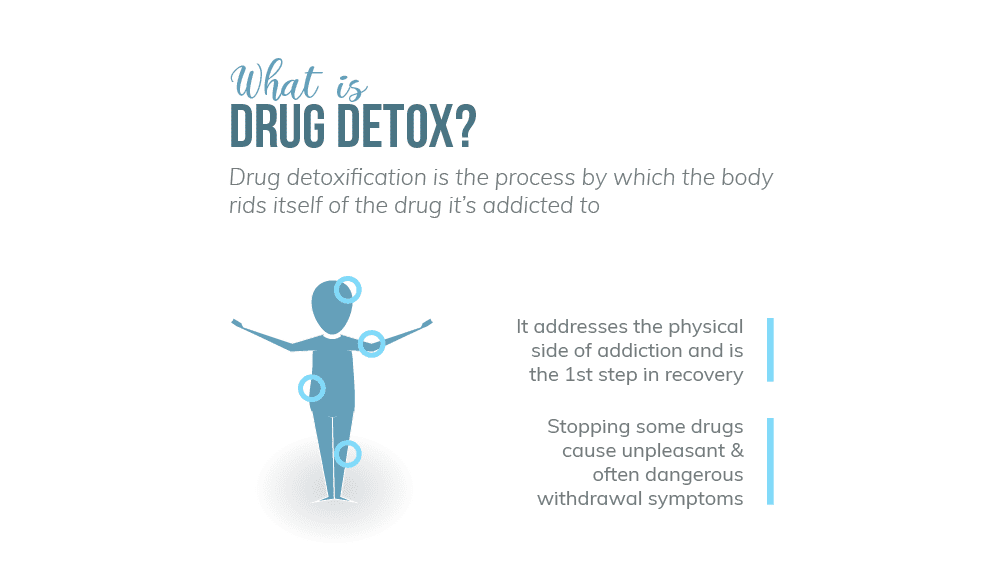
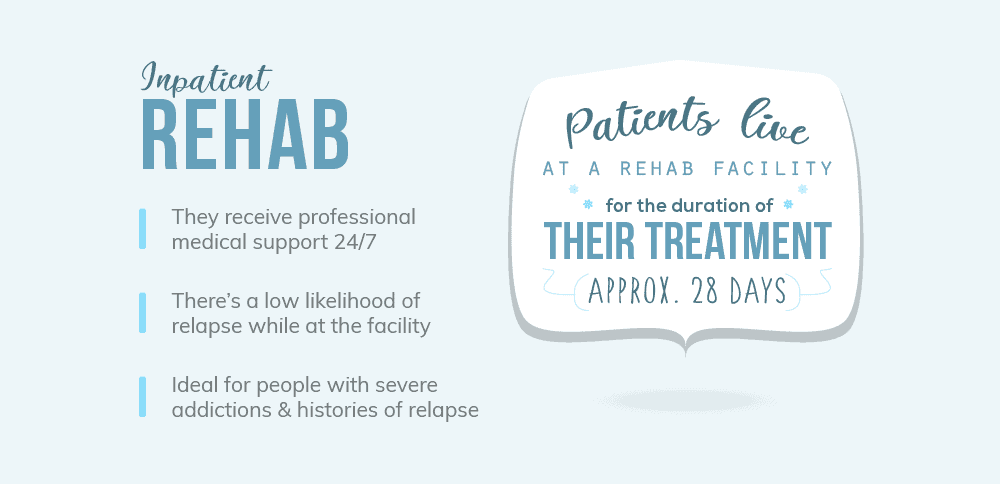
Statistics
The statistics show that drug availability and drug abuse in Oregon is a real and ever-present problem. Despite that fact, there is significant room for improvement of treating drug addiction in Oregon. Recent reports have identified major shortcomings:
- There are approximately 3000 certified addiction counselor’s in Oregon, yet –
- More than 300,000 Oregon residents have a substance abuse disorder that remains untreated.
- Only 35% of patients complete outpatient drug addiction treatment, yet –
- More than half – 58% of patients complete intensive residential/inpatient treatment. The national average is only 45%.
- One out of every six patients who are discharged from residential drug addiction treatment programs in Oregon return to treatment within a year.
- Public funding was used for the addiction treatment programs of 23,000 Oregon residents in 2015.
- The average addiction counselor in Oregon has a caseload that is double the size of the national average.
- One-on-one individual counseling is done at one-fourth the established national standard
- Group sessions are typically twice the recommended size.
What do all of the statistics about drug addiction counseling in Oregon tell us? Most importantly, they reveal that not all substance abuse rehabilitation programs in Oregon are created equal. Because of the shortcomings that have been brought to light, it is now more important than ever for a person needing help to perform their due diligence and research any facilities or programs that they are considering. It’s okay to ask questions because it is YOUR health and YOUR recovery on the line.
The Portland, Oregon Drug Problem is Best Addressed Through Addiction Treatment
If you live in Oregon or neighboring Idaho and you or someone you care about has a problem with drugs or alcohol, NOW is the time to ask those questions, and the experienced professionals at Northpoint Recovery are standing by to give you the answers you need. As the region’s premier addiction rehabilitation facility, Northpoint Recovery can help you sobriety, sanity, and serenity to your life, with a proven, multi-faceted recovery program that can be individually tailored to fit your needs. It’s hard to admit when you no longer have control over your substance abuse problem. This might be something you thought you’d never have to admit. However, once you do, you’ll finally be able to get the help you need to recover. You don’t have to continue your addiction. Help is available for you today.
Do you have questions about your drug problem or how to get help to recover? Please contact us right away to get assistance.
What Did you Think About This Blog?
Give it a Rating!


